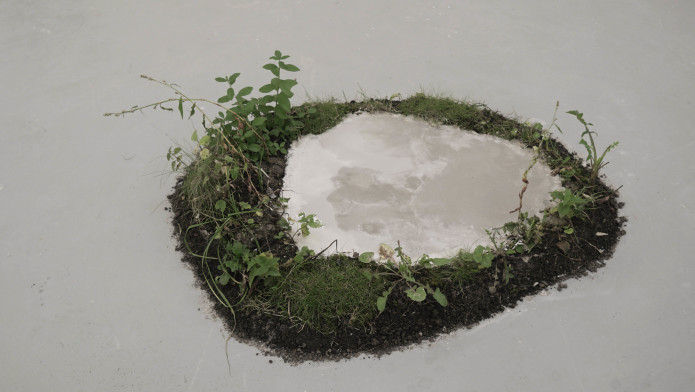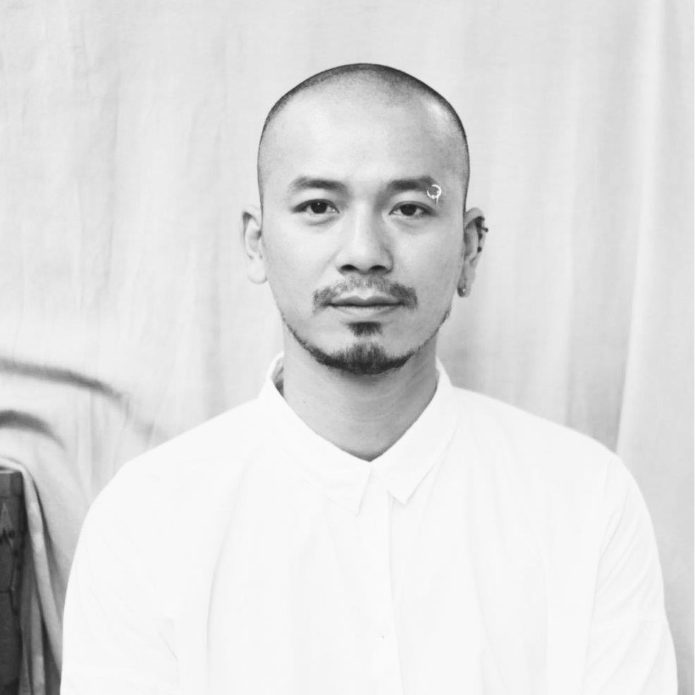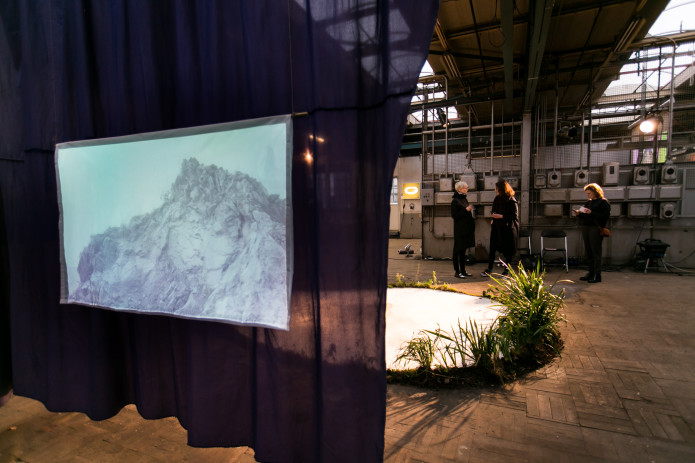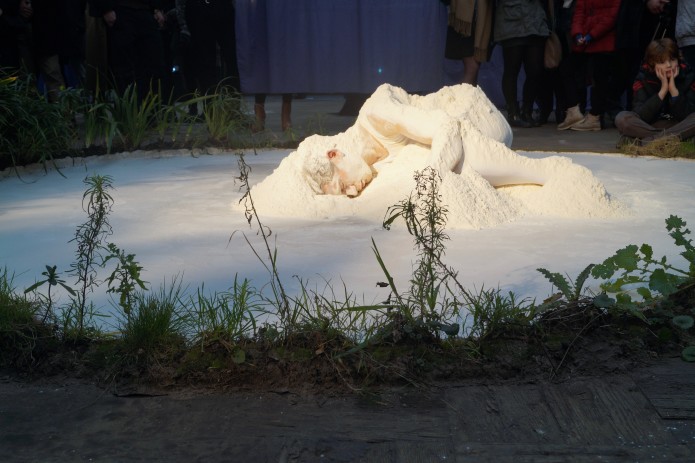
Interview: Artist Tuan Mami
Tuan Mami’s In One’s Breath–Nothing Stands Still (2014-2017), which Framer Framed presented for the Intersections programme of Art Rotterdam in 2017. The multimedia installation is a product of several years of research by the artist into the pollution, loss of biodiversity, and disruption of local culture in Hà Nam, Vietnam caused by years of exploitative stone mining. The subject is an intimate one for the artist because Hà Nam is also his hometown. In relation to this, and to shed light on his practice, Iona Sharp Casas interviewed him.
Could you tell us more about the background of the project that you presented as part of the Intersections space at Art Rotterdam? What made you decide to create this project?
In One’s Breath–Nothing Stands Still is a 4 years’ research project and the social, ecological and political effects of exploitative stone mining in Hà Nam, Vietnam. It is very difficult for me to speak about the time of the project, because it comes from my very deep memories: Hà Nam, is my parents’ hometown. I went there since I was a child, and almost every year or two years I go back there. I could say, then, that I have been observing the space for a very long time. Although I recently decided to make this project, when I was younger I used to go there to swim in the river, and to live inside the forest for days. I really respected the incredible beauty of the place: it’s very close to Hanoi, so I thought of it as a type of paradise – as other places where destroyed after all the wars and the fast development of the country.
However, some years ago, I started to realise it was beginning to change. I didn’t even recognise the change in the early 2000s (when they started to exploit the area), because the results of the exploitation can’t really be seen in one day. It took a while to recognise that everything was lost. Then, years after, I realised I couldn’t do anything there anymore: I couldn’t even swim in the river anymore because it was too polluted.
Throughout the exploitation process the local people lost a lot of their natural resources, as the mining companies took over. The local inhabitants had to invent new ways of gathering food; for instance, they had to throw explosives into the river to be able to fish at a bigger scale. In short, the local inhabitants had to adapt to survive.
It was so sad: the whole scenery changed. Many things were lost. In 2004 I started to feel the pain of it, and the weight of it not only in our Vietnamese society – but as a human development case. In the beginning I didn’t know what to do with this project; I just wanted to stay there and observe what was happening – like an anthropologist, I wanted to learn what was changing. I had three focuses; starting with ecology, which was the core aspect. A second aspect I wanted to focus on was money and politics. This is conflictual, because the local people reached that area centuries ago; but since the government took over the area doesn’t belong to them anymore– so they lost their property. Additionally, when these changes took place the money didn’t go to them but to the companies and government. The third aspect relates to culture: when nature, politics, and the environment change, culture must adapt to it to survive. At the same time, the culture of these minorities lost many of its old, essential qualities: there was a loss of ‘the authentic’, as local people had to change their house designs, their way of dressing, their way of gathering – everything.
Those are the three aspects I focused on to cover my main point, which is about human movement and mobility.
This is very interesting, because it makes your project a case study for a greater global situation in which there are many places that are losing essential parts of their culture, due to having to adapt. It seems like this is part of a bigger trend.
Exactly! For me this is a study case, but I don’t think the matter belongs to a local area or to certain people. This belongs to all of us: not even Vietnamese people only – it is a global case. The issue with movement is that there is always something lost: either you run away, or you adapt. A lot of local minorities don’t want to leave their area, as it is their house. However, nowadays they cannot survive as they used to, which means that many people must run away to other places. There is no difference between this and what is happening globally, with the refugees coming into Europe or at the American borders: it is the same. We need to re-learn about what is happening in terms of global movement.
I have another project (which is quite close to this one, as they are related) about the Vietnamese community that lives in South Korea [Myth East Mist (2015)]. In 10 years, about 65.000 young women left for Korea. You could say they sold themselves to marriage: they are gambling with their lives, as they are taking part in human trafficking. This project really moved me, and I realised that I had to learn more about this. Whilst doing my research, I went to the community where the mothers of these young women live, in South Korea. These people are there to support their daughters, and they are completely isolated. I remember one of the sentences one of the women told me: “I’m waiting to go back to my country, my motherland”. It is a very sad situation, but at the same time they are willing to do this, to have a chance of a better life.
When I finished that project, I realised I wanted to go back to the starting point. Almost all the people who flee their hometowns come from the countryside; which is why I got back to this project [In One’s Breath – Nothing Stands Still]. I wanted to do research on why people have to run away.
To get back to your installation at Art Rotterdam: your project is very immersive. When visitors enter, they are completely immersed in the experience of the installation: it is visual (due to the pictures and the lake), it is auditory (because to the sounds from the videos), tasteful (with the taste of the wine at the end), and even olfactory (due to the smell of the drapes and the cement). Is this your goal when you create the installation: do you want to make it an immersive experience?
Absolutely. When I make art, I am not trying to create an artwork per se. My work is based on research, so I create a story to present the research; otherwise, I would feel like something is lacking. For my project at Art Rotterdam (as well as for other projects) I try to build a story, a myth: people should go through it, be part of it; go along and discuss through the structure of the work. My works are performative installations: people have to put themselves through it.
I often say that I don’t want to absorb people with the beauty of something: I want to build something that requires their attention and patience.
I understand that behind your project there are many hours of research and investigation that are spent there, on location, speaking to people from Hà Nam. What are the responses of the local inhabitants of Hà Nam to your project: do they show interest in your work, and see it maybe as a future, political grassroots tool; or are they suspicions and prefer to not take part in it?
This is also very unclear to me. The project is based on local people; but they have fallen into a horrible trap of lies and money. Because of this, they don’t trust anyone. I went to some of their meetings; they have built a very small and closed community that survives together and doesn’t trust anyone else. When I talk to them they are very supportive and helpful, but at the same time they are a nervous. Some think I am a spy of the government, and they worry that I might bring them to other traps.
I also have to fight a lot with them because they are very negative. For example, when I wanted to change their curtains and give them new ones (to bring theirs to the installation), they didn’t understand why I was doing it. I told them this might make their case known and perhaps even help forge negotiations with the government, but they still didn’t trust me. Although they know this was good for them, they thought it might be a new trap. I then had to fight with them and tell them: “you have to believe me. This is my hometown too. I fight for you, but you also should fight for yourself. Otherwise, how can I help you?” I put a lot of passion into it; and then many of them listen.
Moving on to a different question, concerning the title of the project (In One’s Breath – Nothing Stands Still): what does it capture?
To be honest; for long periods of my research was lost. These issues were too big for me, as an artist (I consider myself an artist: I don’t want to be a social researcher or activist, as they are not my skills). Even early last year, I almost quit the project after more than 3 years. I felt upset with myself because I couldn’t do anything. But then, last summer, I went back there, and there were a lot of protests: local people took the streets to protest against the companies and government. This was a tiresome period, as people worked during the day, and protested at night (sometimes, for up to 3 months). The government answered very violently to the revolts – and still, no one outside of the area heard of them.
The protests were very isolated. I worked with the locals, and many times I couldn’t even enter the mining area – so I walked around neighbouring places that were more quiet and peaceful. At some point, I found a quiet spot and looked down onto the mining area, which completely changed my point of view: inside the mining area it’s so dirty and violent, but looking at it from a distance makes it even look romantic. The distance made it look beautiful and still: I couldn’t see the movement or the details.
The scenery reminded me of a sentence by Buddha where he says something like, “in our human life, we live only in one breath”. This sentence has many different layers; and it opens questions about consciousness and awareness – specially awareness of living, of your instincts, and of time. It speaks about developing and improving oneself: how can you perceive the outer world? This sentence really brought me to that moment; of movement and non-movement, beauty and ugliness. For this reason, I adopted this sentence from Buddhism and used it for my project.
It also has a very critical component, through which I want to question the concept of movement – particularly in the case of my videos, where everything is still and the scenery is beautiful. With these videos, I wanted to capture images that reminded me of old, romantic landscape paintings: even the dust created a foggy atmosphere. However, when you look close, you recognise it is violent and brutal: the fog turns out to be dust, and the beautiful landscape is full of pain.
Knowing that the title is about that, it also has a very critical wake-up call element. It seems to tell people that they need to be conscious about what is happening.
Yes. A lot of pieces in my work are based on this sentence; for example, the lake. The lake looks beautiful; like a frozen lake, like winter in the West. But then, no one could understand how the lake was created. Even local people and myself, we couldn’t understand how the human mind could create such an artificial thing: slowly, over the years, the dust mixed with the water and turned into concrete. The unconsciousness of human creation is crazy: we have created it, but we don’t know how.
That ties into my last question. On your website, curator Bill Nguyen writes the following text about In one’s breath – nothing stands still:
“the project speaks on a much large scale, and is not merely a reflection or criticism of the situation, but rather a lyrical expression of a global phenomenon, a (dys)utopia casting an ominous shadow, hovering between dreams and nightmares, resurrection and extinction, past and future. It is at this very crossroad that we realize, humanity – for all its contemplating, scrutinising, reflecting and wondering – is once again trapped in the obliteration of their own creation.”
I find this connects very beautifully with everything that we’ve been speaking about. But I also find interesting that amid all this catastrophe and ugliness, you decided to end the installation structure in Art Rotterdam with a drink, serving it the visitors who wanted it. Perhaps you are portraying a sort of hope: do you want to convey a return to nature, a return of the power to the people? Why did you decide to end the installation in this way?
Bill [Nguyen] wrote this poem – which is supposed to be my exhibition statement – based on mythology, which I also use a lot in my work. The poem takes inspiration from the old hippies of Vietnam, who talked about how during the primitive times human beings grew up surrounded by nature, and how in all this messiness God brought us to a rich and colourful life. By the end of the poem, Bill reminds us that the tale ends where it began.
This is my structure: I want to bring back life as we know it (with all its disaster and messiness) slowly back to the beginning, and think – in very ironic ways – of how we can re-build it and develop it anew. This is a very critical thought: it is a journey about what would happen if we were brought back to primitive times. To come back to the performative installation in Art Rotterdam; I want the drinking installation to be the end of the show. This way, it is meant to create dialogue: it is the end, but also the starting point of a discussion. It is a very tight structure that closes the installation, but also opens a conversation. The drinking is a break at the end of the exhibition, and makes visitors wonder: why are were here, and what are we drinking?
Additionally, the act of drinking also has an interesting story: a story of humans exploring and exploiting nature, understanding and living with it, and keeping it alive for everyone together. My installation has a lot of belief in that: understanding how we relate to nature. That is the dynamic of the project.
Tuan Mami was interviewed by Iona Sharp Casas
Migration / Ecology / Extractivism / Performance /
Exhibitions

Exhibition: In One's Breath - Nothing Stands Still
Framer Framed is part of international art fair Art Rotterdam (2017) with work by Tuan Mami
Network



